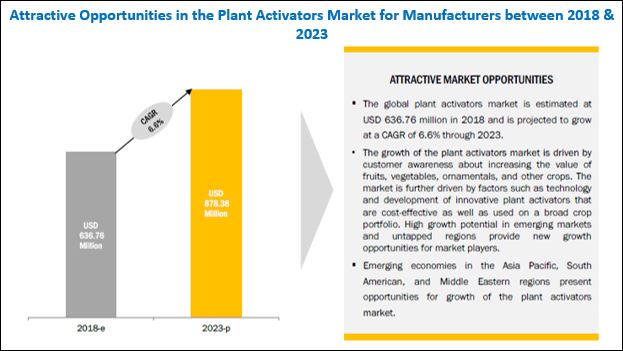The plant activators market is estimated at USD 636.76 Million in 2018 and is projected to reach a value of USD 878.38 Million by 2023, at a CAGR of 6.6% from 2018 to 2023. The market is driven by factors such as growing consumer preference for organic foods, new product registrations, decrease in arable land, and technological advancements in the agricultural industry. On the other hand, lack of awareness, increased prices of raw materials, and high R&D costs are the key factors hindering the growth of this market. This indicates that there is immense scope for the growth of the plant activators market, globally.
Download PDF brochure: https://www.marketsandmarkets.com/pdfdownloadNew.asp?id=103570996

On the basis of source, the biological segment dominated the plant activators market in 2017. Biological plant activators play an important role in plant growth as they help improve nutrient use efficiency. Biological products are made from naturally occurring substances that can work alone as well as complement traditional methods of plant production and protection. Their benefits include improving crop nutrient, promoting growth & yield, and providing insect control and disease protection. The high cost of developing new chemical pesticides, increase in insect & weed resistance to chemical treatments, and high regulatory pressure to limit chemical usage with respect to ecosystem damage have contributed to the need for these biological products
On the basis of crop type, the fruits & vegetables segment accounted for the largest market share; this can be attributed to growing health-consciousness among consumers and rising incomes which result in increased consumption of a wide variety of products, particularly fruits & vegetables. The rise in the production of fruits & vegetables results in an increased demand for plant activators. The high export potential of these products has also led to an increase in production levels. In North America and Europe, health concerns are driving the demand for organic fruits & vegetables, as consumers prefer healthier and more nutritious options in their diet.
On the basis of form, the market was led by the solutions segment in 2017. Solution compositions, also known as flowable concentrates, are mainly in the form of emulsifiable suspensions or soluble liquid concentrates. Solution formulations are mainly preferred as they do not cause dust formation on spraying, do not cause toxicity or flammability, provide high efficiency due to smaller particle size, and low packaging volume. Moreover, foliar spray is the most widely used mode of application owing to its ease of application and high effectiveness.
Speak to Analyst: https://www.marketsandmarkets.com/speaktoanalystNew.asp?id=103570996
European agriculture is driven by technical advancements, economics, politics, climatic changes, and consumer demand. Plant activators have received wide-scale acceptance in Europe as they are expected to increase long-term agricultural productivity and help realize the goal of food self-adequacy.